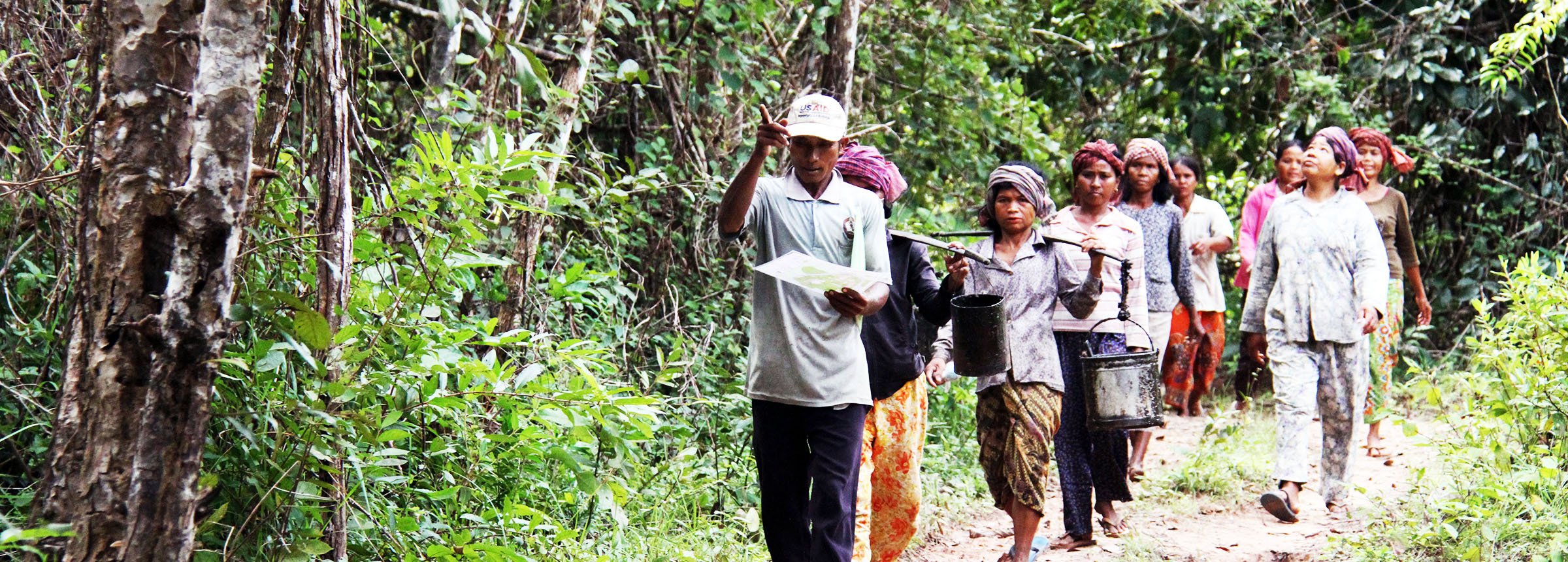
Juliflorae acacias – new food source for the Sahel
NFTA 93-01, March 1993
A quick guide to useful nitrogen fixing trees from around the world
The seeds of certain Acacia species were an important traditional food resource for Australia’s desert Aborigines (Crawford, 1982; O’Connell et al., 1983; Latz, 1984; Brand and Cherikoff, 1985; Orr and Hiddens, 1987). According to a recent review (Thomson, 1992), 44 of the 125 Acacia species found in the deserts of subtropical Australia have some potential as sources of human food, including the A. holosericea/cowleana group, A. tumida and A. adsurgens from the large section Juliflorae. These species have a colonizing habit and are characterized by:
- Precociousness, producing seed within 18 to 24 months of planting
- High self fertility
- High fecundity, setting heavy seed crops two to three years after planting
- A short life span of only 5 to 10 years.
They have exhibited very good or outstanding growth and adaptation to other tropical dry zones, notably the Sahelian zone of West Africa (Cossalter, 1987). They have a major, but scarcely tapped, potential to provide a protein-rich food source, particularly as famine reserve food, for the people living in semi-arid regions of sub-Saharan Africa.
Taxonomy and genetic resources
Acacia holosericea/cowleana group. Recent laboratory and field research has revealed that the widely planted
A. holosericea consists of at least four distinct entities of differing ploidy levels (Moran et al., in press; Maslin and Thomson, in preparation). The diploid (2n = 26) species, A. neurocarpa, occurs in moist niches in northwestern Australia and Northern Territory. Key morphological traits are:
- Large, broad phyllodes, especially pronounced in young plants
- Stout, flattened branchlets
- Long ( 2 mm) linear bracteoles.
The tetraploid (2n = 104) species, A. holosericea, occurs in riverine and woodland habitats in subhumid parts of northern Australia. The pods of both A. neurocarpa and A. holosericea are tightly and irregularly coiled.
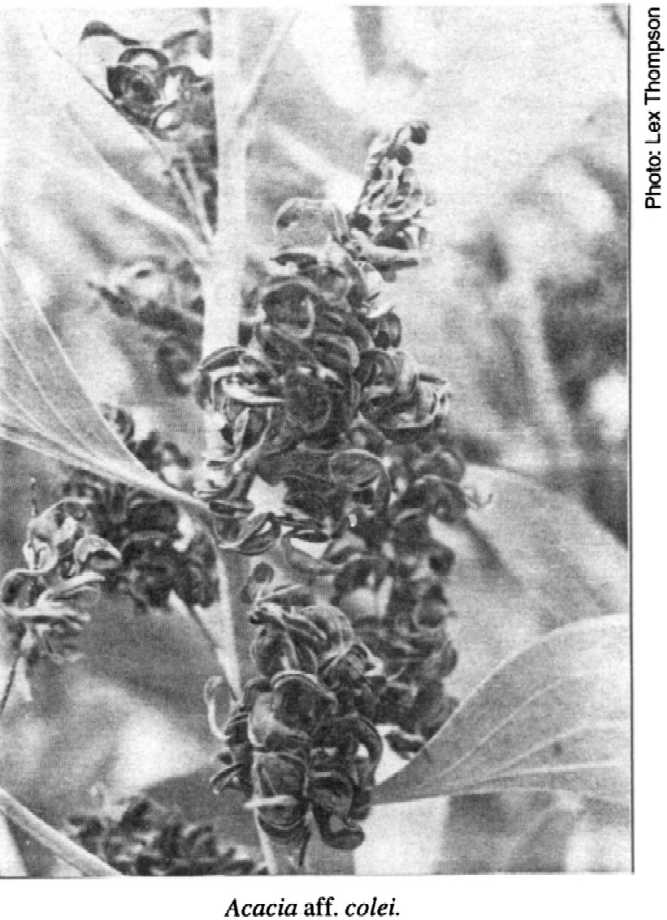 The hexaptoid species, A. colei ms, is widespread in the semi-arid zone of northern Australia. It appears to have evolved as a result of past hybridization between A. neurocarpa and A. cowleana (a tetraploid species). Fruiting plants of A. colei ms are readily distinguished from A. neurocarpa and A. holosericea by their strongly and openly curved pods. A fourth undescribed entity, A. aff. colei, bears a close resemblance to A. colei ms, but is distinguished by its curly pods.
The hexaptoid species, A. colei ms, is widespread in the semi-arid zone of northern Australia. It appears to have evolved as a result of past hybridization between A. neurocarpa and A. cowleana (a tetraploid species). Fruiting plants of A. colei ms are readily distinguished from A. neurocarpa and A. holosericea by their strongly and openly curved pods. A fourth undescribed entity, A. aff. colei, bears a close resemblance to A. colei ms, but is distinguished by its curly pods.
All four species have been subject to field trials in West Africa. They have proven to be fast growing, adapted to most soil types including sands and skeletal soils, and not prone to termite attack or browsing by livestock. Acacia colei ms has shown excellent adaptability to the Sahelian belt of West Africa since its introduction in the early 1970s under the name
“A. holosericea” (Mandora provenance) by the Centre technique forestier tropical (Cossalter, 1987).
Acacia colei ms holds great promise for human food production in dry regions of tropical Africa. It tolerates prolonged dry periods and bears heavy seed crops that are easy to collect and clean. The seeds are readily released by fully mature pods, without resorting to pounding that may release an irritating dust. Plants are highly self-fertile, with little apparent within-species variation.
Acacia cowleana is another fast growing large shrub or small tree with a wide distribution in the semi-arid, subtropical areas of northern Australia. Isozyme studies found only limited intraspecific variation, mainly between populations (Moran et al., 1992). This species performed well in several trials in West Africa. It proved especially promising for sandy soils in southern Niger. However, field trials near Ouagadougou, Burkina Faso, revealed substantial differences in the growth and survival rates of different provenances (IRBET/CTFT, 1989).
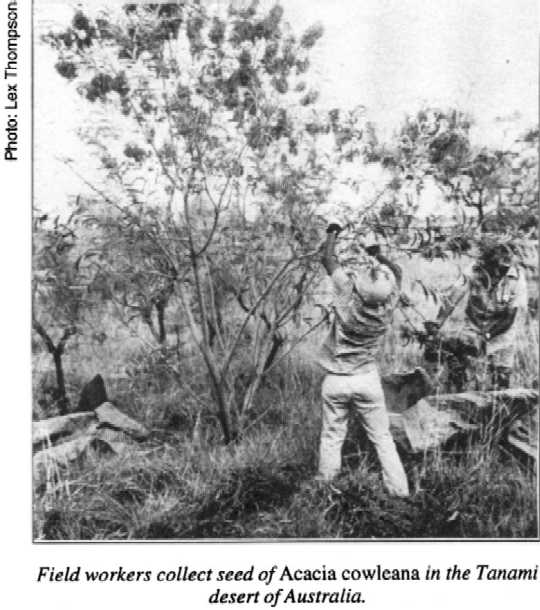 Acacia cowleana appears to be directly involved in the evolution of two other species with potential as human food- A. oligophleba and A. aff. cowleana. Acacia oligophleba is a multistemmed large shrub or small tree from warm to hot, subtropical to semi-arid, zones of northwestern Queensland and Northern Territory. Its general appearance suggests a vigorous form of A. cowleana. Pedley (1978) gives a botanical description. One seedlot (CSIRO S13774), under the name “A. cowleana”, was included in the FAO/CSIRO series of international provenance trials for A. aneura. At Bandia, Senegal, A. oligophleba grew quickly at first, but plants started to die out after about five years. In ACIAR/QDF trials in southeast Queensland, A. oligophleba reached an average height of 3.3 to 4.0 m after 3.5 years (Ryan and Bell, 1989). Plants flower precociously-at 15 months in southeastern Queensland-and produce heavy seed crops following good summer rains.
Acacia cowleana appears to be directly involved in the evolution of two other species with potential as human food- A. oligophleba and A. aff. cowleana. Acacia oligophleba is a multistemmed large shrub or small tree from warm to hot, subtropical to semi-arid, zones of northwestern Queensland and Northern Territory. Its general appearance suggests a vigorous form of A. cowleana. Pedley (1978) gives a botanical description. One seedlot (CSIRO S13774), under the name “A. cowleana”, was included in the FAO/CSIRO series of international provenance trials for A. aneura. At Bandia, Senegal, A. oligophleba grew quickly at first, but plants started to die out after about five years. In ACIAR/QDF trials in southeast Queensland, A. oligophleba reached an average height of 3.3 to 4.0 m after 3.5 years (Ryan and Bell, 1989). Plants flower precociously-at 15 months in southeastern Queensland-and produce heavy seed crops following good summer rains.
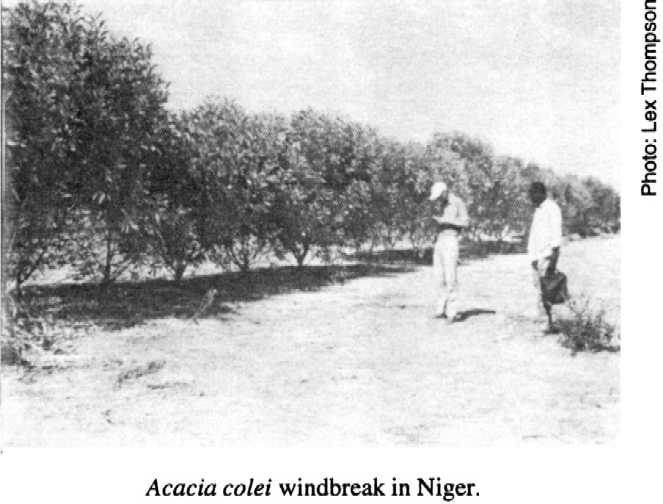 Acacia aff. cowleana is a spreading shrub that grows on rocky sites in semi-arid areas of northern Australia. It appears to have arisen through hybridization between A. cowleana and A. gonoclada and closely resembles A. cowleana. Until recently, the two species were confused. New shoots of A. aff. cowleana are covered with reddish-brown resin and this provides a useful distinguishing feature. This species has a unique capacity to produce moderately heavy seed crops from difficult, rocky sites, including those with a lateritic hardpan.
Acacia aff. cowleana is a spreading shrub that grows on rocky sites in semi-arid areas of northern Australia. It appears to have arisen through hybridization between A. cowleana and A. gonoclada and closely resembles A. cowleana. Until recently, the two species were confused. New shoots of A. aff. cowleana are covered with reddish-brown resin and this provides a useful distinguishing feature. This species has a unique capacity to produce moderately heavy seed crops from difficult, rocky sites, including those with a lateritic hardpan.
Acacia tumida. A fast growing, multistemmed shrub or small tree from the semi-arid to subhumid zones of northwestern Australia, A. tumida has performed well in field trials in Niger, Burkina Faso and Senegal. This species is well adapted to infertile soils, including podzols, laterites and loose, drifting sands. Populations vary considerably in many characters, including plant habit, coppicing ability and seed size. Acacia tumida hybridizes with A. difficilis, A. eriopoda and, less frequently, with A. trachycarpa (Thomson, 1992). Turnbull (1986) provides a full description.
Acacia adsurgens. A moderately fast growing, multi-stemmed shrub from semi-arid regions of northern and central Australia, A. adsurgens is well adapted to sandy soils. The species is fully described by Thomson and Hall (1989). It has been observed to produce heavy seed crops on infertile sands in southern Niger.
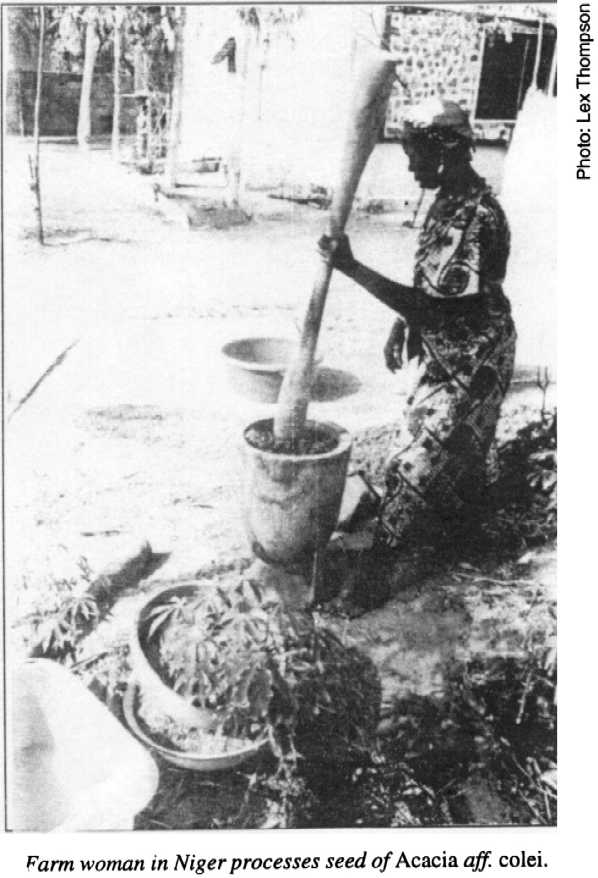 Yield potential
Yield potential
Flowering and seed set in these species depend on the amount and distribution of rainfall in the previous rainy season and on any subsequent, out-of-season rains. In northern Australia, Juliflorae acacias set heavy seed when cumulative rainfall is at least 300 to 400 mm, especially when rain is concentrated towards the end of, or even after, the main rainy season. Clearly, these acacias are capable of producing a useful seed crop in years that are unfavorable to short-duration rainy season crops such as maize, millet or sorghum.
In native stands, typical yields are 250 to 500 g tree-1, but mature specimens can yield up 1 to 2 kg of clean seed. There is little information on seed production in plantations. Yields are affected by many factors-such as moisture regime, insect predation and management-but seed production in managed plantations at wide spacings (for instance 5 x 5 m) will normally exceed 100 kg ha -1.
In northern Australia, predation by various insect pests, such as chalcid wasps, may cause considerable seed destruction. Appropriate quarantine measures are crucial to prevent the accidental entry of Australian insect pests into other regions where these trees are introduced. Fortunately, the Bruchid beetles that cause extensive damage to seed crops in African acacias do not appear to be a serious problem for the Australian Juliflorae species (Doran et al., 1983).
Utilization
Until recently, knowledge of the use of Australian acacia seeds as human food came exclusively from the desert dwelling Australian Aborigines. Once the pods have turned brown and begun to split, the seed can be harvested quickly by beating the pods onto a large sheet or tarpaulin spread underneath the tree. A particularly efficient technique is to cut the small pod-bearing branches and beat them directly onto a sheet. The seeds of these species, especially A. colei ms and A. tumida, may be cleaned with minimal threshing or winnowing. If rubbed in water, the empty seeds and arils float off.
The dry seeds may be lightly roasted and ground with a little water into a paste: the flavor has been likened to peanut butter (Latz, 1984). The roasted or unroasted seeds may be ground into flour with a stone or wooden mortar and pestle or with a mechanical mill such as used for grinding rnillet. Acacia seed flour can be mixed with water and cooked as unleavened bread or mixed with wheat flour and baked into bread (20% acacia flour according to Thorbum et al., 1987) or biscuits (50% acacia flour according to Maggiore, 1985).
The large seeds of A. tumida can also be consumed green (Crawford, 1982). Green pods are readily harvested, but near mature seeds are only available for three to four weeks. The green pods should be lightly roasted to force them open and to dry up any bitter juices. The flavor of green acacia seeds has been likened to peas, but in the case of A. tumida there is a somewhat unpleasant aftertaste.
Recent experience in southern Niger suggests that A. aff. colei is readily integrated into traditional agriculture and enjoys a high level of acceptance as a food source (T. Rinaudo, SIM International, personal communication). No aspect of seed preparation requires new technologies or special skills. The question of acceptability of acacia seed food products is still unanswered in other parts of Africa. Important aspects are texture, taste, appearance and ease of preparation.
With their hard coats, the seeds may be stored at ambient tropical temperatures without deterioration for more than 10 years. If wetted, they neither germinate nor rot easily, making them an ideal food reserve for times of famine.
Food value. The seeds of the Juliflorae acacias are rich in nutrients, with high protein, energy and fat contents. The high protein content is noteworthy as the diet in dry sub- Saharan Africa is often lacking in protein, especially for children. Of total dry seed weight, A. adsurgens is 26% protein (Maggiore and Latz, unpublished), A. “holosericea” is 21% (Peterson, 1978), and
A. cowleana is 22 to 24% protein (Maggiore and Latz, unpublished). Acacia seed proteins include globulins, and to a lesser extent, albumins that provide a well-balanced source of essential amino acids.
Toxicity. The seeds of most pods contain some potentially toxic proteins, but these are denatured by cooking. Proteinase inhibitors, affecting trypsin and chymotrypsin, have been found in seeds of A. cowleana and other species, but only at levels similar to those found in peas or beans much lower than levels in soybeans or winged beans (Kortt, 1984). The seeds of these species are reported to be free of the serious neurotoxins present in the seeds of African acacias (Murray, 1984). Further research is required on possible toxic or anti- nutritional components, but these are unlikely to constitute a hazard in species widely eaten by Australian Aborigines.
Silviculture
Establishment The Juliflorae acacias are easily propagated from seed and readily established in the field, either from container-grown seedlings or by direct seeding. Germination is enhanced by immersing the seeds in rapidly boiling water for 60 seconds. The recommendation is to maintain seedlings in a nursery for 10 to 14 weeks. In hot weather, germination usually occurs within seven days and seedlings grow quickly. Inoculation with an effective strain of a Bradyrhizobium root symbiont may promote uniform seedling growth, but is not essential. Turnbull (1986) gives more information on establishment practices for particular species.
Direct seeding is a promising technique for establishing broad scale plantings. Pretreated seeds should be sown either just before or at the beginning of the rainy season. This approach has proven successful in trials in northern Nigeria and Senegal. However, direct seeding with A. colei ms failed at Tanout, Niger, where annual rainfall was only 170 to 200 mm (P. Beckman, Eden Foundation, personal communication). Successful establishment by direct seeding probably requires rainfall lev els of 350 to 400 mm.
Planting systems. In many parts of the Sahel, low bushy windbreaks of Juliflorae acacias could help crop establishment by reducing wind speed and sand blasting. However, competition for soil moisture will probably limit the intercropping potential of these trees in the harsh Sahelian environment. Single or staggered double-row windbreaks, positioned perpendicular to damaging winds at intervals of 40 to 50 in, may provide an effective compromise between conventional windbreaks and alley-cropping systems.
These trees can grow on difficult sites that are unsuitable for traditional crops. Acacia tumida has great potential for stabilizing moving sands, while A. cowleana and A. colei can tolerate hardpan near the soil surface. Low planting densities, of about 400 trees ha-1, are suitable for non-arable sites where the objective is to maximize seed production.
Farmers in West Africa are increasingly planting Juliflorae acacias in and around their villages for shade and ornamental purposes. There is considerable opportunity to expand these plantings for combined food and fuelwood production. There is also scope for interplanting fast-maturing Juliflorae acacias with slower developing, but valuable local trees such as Faidherbia albida (for fodder) or Securidaca longipedunculata (for medicine). When planted in suitable arrangements, the Juliflorae acacias can help protect these trees and provide early yields of food and fuelwood.
Pruning regimes. Most of the Juliflorae acacias that hold promise for food production have poor coppicing ability. The exception is certain populations of A. tumida that can regrow from basal coppice and root suckers. Most species respond well to light pruning and pollarding, and these practices, when properly applied, may increase plant longevity by several years.
The extent and vigor of regrowth depend on season of cutting, cutting height and retention of phyllode-bearing branches. In Niger, A. colei ms regrew best after cutting in June, while in Senegal the best regrowth was after cutting between May and July. The recommended cutting height is 1 m, retaining at least one phyllode holding branch. Plants have been observed to set moderately heavy seed crops within a year of heavy pruning.
Research needs
Wider use of the Juliflorae acacias as human food requires further investigation in several areas. These include yield potential, management and possible toxic effects associated with long-term high rates of ingestion. The Australian Tree Seed Center (CSIRO Division of Forestry) is currently identifying priority areas for future research and plans to coordinate such activities. Pilot evaluations are urgently needed in different areas of sub-Saharan Africa.
Seed source
Seed of A. colei, A. cowleana, A. aff. cowleana and A. oligophleba is available from Future Forests. They can be contacted by FAX at (613) 306-6094.
Further reading
Brand, J.C. and Cherikoff, V. 1985. The nutritional composition of Australian Aboriginal food plants of the desert regions. In G.E. Wickens, J.R. Goodin and J.V. Field, eds. Plants for and lands. London: Allen and Unwin, pp. 53-68.
Cossalter, C. 1987. Introducing Australian acacias in dry tropical Africa. In J.W. Turnbull, ed. Australian acacias in developing countries. Proceedings 16. Canberra: ACIAR, pp. 118-22.
Crawford, I.M. 1982. Traditional Aboriginal plant resources in the Kalumburu area: aspects in ethno-economics.
Records of the Western Australian Museum. Suppl. 15.
Doran, J.C., Turnbull, J.W., Boland, D.J. and Gunn, B.V. 1983. Handbook on seeds of dry-zone Acacias. Rome:
FAO.
IRBET/CTFI’ (Institut de recherche en biologie et écologie tropicale/Centre technique forestier tropical). 1989. Rapport
annuel d’ activités. Ouagadougou: IRBET/CTFT.
Kortt, A.A. 1985. Characteristics of the proteinase inhibitors of Acacia seeds. In G.P. Jones, ed. The food potential of seeds from Australian native plants. Victoria (Australia): Deakin University Press, pp. 121-45.
Latz, P.K. 1984. Bushfires and bushtucker: Aborigines and plants in central Australia. M.A. thesis. Armidale
(Australia): University of New England.
Maggiore, P.M.A. 1985. Utilization of some Australian seeds in edible food products. In G.P. Jones, ed. The food potential of seeds from Australian native plants. Victoria (Australia): Deakin University Press, pp. 59-73.
Maslin, B.R. and Thomson, L.A.J. In preparation. Reappraisal of the taxonomy of Acacia holosericea A. Cunn. ex Don, including the description of a new species, A. colei, and the reinstatement of A. neurocarpa A. Cunn. ex Hook.
Moran, G.F., Thomson, L.A.J., Grant, J.E. and Bell, J.C. In press. Genetic diversity in Acacia holosericea. In A.P.N. House and C.E. Harwood, eds. Australian dry-zone acacias for human food. Canberra: Australian Tree Seed Centre, CSIRO Division of Forestry.
Murray, D.R. 1984. The food value of Acacia seeds. Australian Plants. 13(101):25-26.
O’Connell, J.F., Latz, P.K. and Barnett, P. 1983. Traditional and modern plant use among the Alyawara of central Australia. Economic Botany. 37(t):80-109.
Orr, T.M. and Hiddens, L.J. 1987. Contribution of Australian acacias to human nutrition. In J.W. Turnbull, ed. Australian acacias in developing countries. Proceedings 16. Canberra: ACL,KR, pp. 112-15.
Pedley, L. 1978. A revision of Acacia Mill. in Queensland. Austrobaileya. 1(2):75-234.
Peterson, N. 1978. Traditional patterns of subsistence in 1975. In B.S. Hetzel and H.J. Frith, eds. The nutrition of Aborigines in relation to the ecosystem of Central Australia. Melbourne: CSIRO.
Ryan, P.A. and Bell, R.E. 1989. Growth, coppicing and flowering of Australian tree species in trials in southeastern Queensland, Australia. In D.J. Boland, ed. Trees for the tropics: growing Australian multipurpose trees and shrubs in developing countries. Monograph 10. Canberra: ACIAR, pp. 49-68.
Thomson, L.A.J. 1992. Australia’s sub-tropical dry-zone Acacia species with human food potential. In A.P.N. House and C.E. Harwood, eds. Australian dry-zone acacias for human food. Canberra: Australian Tree Seed Center, CSIRO Division of Forestry, pp. 3-36.
Thorbum, A.W., Brand, J.C., Cherikoff, V. and Truswell, A.S. 1987. Lower postprandial plasma glucose and insulin after addition of Acacia coriacea flour to wheat bread. Australia and New Zealand Journal of Medicine. 17:24-26.
Turnbull, J.W. 1986. Multipurpose Australian trees and shrubs.- lesser-known species for fuelwood and agro-
forestry. Monograph 1. Canberra: ACIAR.
Written by Lex Thomson, Reforestation Consultant, 18 Etheridge Street, Page, ACT 2614, Australia
A publication of the Forest, Farm, and Community Tree Network (FACT Net)
